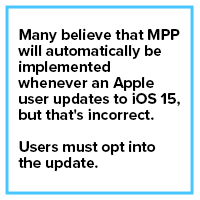Apple's Mail Privacy Protection Is A Help, Not A Hurdle For Email Marketers


May 12, 2022
Email marketing has long been the preferred marketing channel for organizations but when Apple introduced Mail Privacy Protection (MPP) almost a year ago, it caused many marketers to question its future effectiveness. What used to be a sure-fire way to both reach audiences and measure engagement, now was feared to be a broken system that would inflate analytics.
Since going into effect on September 20, 2021, email marketing has not come to and end. As a publisher who sends over 2,000 email newsletters weekly for our partners, we can assure you that email is still a valuable medium. In fact, MPP can help organizations pay closer attention to the most relevant, defined data which will better determine the success of campaigns. For us who use email to attract, gain and earn for our organizations, it's important to educate ourselves on how privacy and protection features affect marketing efforts.
As a quick review, Mail Privacy Protection is an Apple Mail feature that prevents the use of invisible pixels to collect information from email newsletter recipients. Available to all Apple users, this feature allows them to mask information and activity linked to their device. Simply stated, a recipient can hide when and where they opened the email, and what device they used.
Any email whether it’s from Outlook, Gmail or Yahoo is affected when it’s delivered to the Apple Mail app and the user selects the MPP functionality. According to a January 2022 Litmus report Apple’s email client market share was more than double of its competitors at 57.15%.
Historically, pixels were embedded within an email to allow a provider to determine if a user has opened an email by recording if the images were loaded. While this was never 100% accurate, it was reliable and measurable. The MPP release, though, automatically loads all images in an email that’s delivered to the Apple Mail app, giving the appearance of an open. To that end, the false opens will ultimately inflate the open rate in your metrics.
“The fact that we can no longer measure open rates accurately doesn’t mean that people stopped reading emails. Email engagement hasn’t changed as result of privacy controls,” Multiview CSO, Yariv Drori, said. “We must adapt and change how we evaluate email engagement given the data that we do have. Leverage meta data to glean insight about the engagements we can still measure. Insights about WHO engaged with emails, and context signals that tell us WHAT readers engage with will become the new focus for email reports.”
MPP will not influence your total clicks and conversions, which will remain a dependable avenue to measure the success of your email. In fact, here’s a breakdown of what you can still measure even with MPP in effect.
Begin doing A/B testing with the different metrics above to really determine success, which will ultimately provide you with more subscriber-centric information. For example, you can compare the click rate on campaigns that were delivered to similar-sized distribution lists to determine which email campaigns were the most engaging.
With all the information at your fingertips, you won’t have to worry about the inflation of open rates. A comprehensive approach to email analytics based on clicks, website visits, conversions and behavior is far more valuable to determining engagement and success.
MPP is not the end of email campaigns, we can promise you that. In fact, Google is said to release a similar – but different – approach mid-late 2023.
How many emails are you getting each day? Based on that number, how many emails do you think our members – and prospects -- are receiving? We ask...
MoreIn an era where innovation and adaptability are keys to thriving, your organization deserves a partner that understands your unique challenges and...
MoreMarch Madness is back in full swing, with Selection Sunday set for March 17th! This thrilling wave of competition, passion, and brand recognition...
MoreComplete the form and we'll connect with you right away.
You are now in accessibility mode. To restore settings to default, click the accessibility icon on the right hand side.